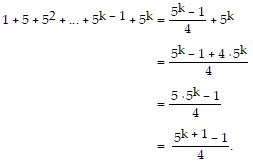Use the Principle of Mathematical Induction to show that the statement is true for all natural numbers n.1 + 5 + 52 + ... + 5n - 1 = 
What will be an ideal response?
First, we show that the statement is true when n = 1.
For n = 1, we get 1 (or 5[(1) - 1]) =  =
=  = 1.
= 1.
This is a true statement and Condition I is satisfied.
Next, we assume the statement holds for some k. That is,
 is true for some positive integer k.
is true for some positive integer k.
We need to show that the statement holds for  . That is, we need to show that
. That is, we need to show that

So we assume that  is true and add the next term, 5k, to both sides of the equation.
is true and add the next term, 5k, to both sides of the equation.
Condition II is satisfied. As a result, the statement is true for all natural numbers n.
You might also like to view...
Use logarithmic differentiation to find the derivative of y.y = 
A. 

B. 

C.  +
+  -
- 
D. ln x +  ln(x5 + 1) -
ln(x5 + 1) -  ln(x + 1)
ln(x + 1)
Solve the problem.The initial value problem models the payoff of a loan. Solve the initial value problem for t ? 0, and determine the first month in which the balance is zero. B'(t) = 0.001B - 200, B(0) = 10,000
A. B = 20,000 + 19,000e0.001t, reaches a balance of zero after approximately 61 months B. B = 20,000,000e0.001 + 2,000,000e0.001t, reaches a balance of zero after approximately 101 months C. B = 20,000 - 19,000e0.001t, reaches a balance of zero after approximately 41 months D. B = 200,000 - 190,000e0.001t, reaches a balance of zero after approximately 51 months
Write the percent as a fraction in lowest terms. 12.5%
A. 
B. 
C. 
D. 
Solve the problem.If sin ? =  , find csc ?.
, find csc ?.
A. 9
B. 
C. - 
D. undefined